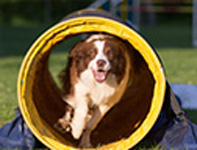Canine Sports Medicine

Sports medicine is a field of medicine that deals with the diagnosis, treatment and prevention of sports-related injuries and improvement of fitness and performance. Canine sports medicine is the branch of veterinary medicine dedicated to the treatment and prevention of injuries your canine athletes may sustain during sporting activities.
Canine sports medicine typically involves a combination of pain management, physical treatments, exercise programs and other modalities, and even surgery if necessary. The most important element of canine sports medicine is improving the athleticism (strength, fitness, and agility) of your canine. As canine sports become more popular, incidences of canine injuries too are increasingly reported. Your canine athlete can greatly benefit from sports medicine.
Canine sports medicine can be divided into pre-performance or post-performance. Pre-performance sports medicine usually deals with training, nutrition and prevention of injuries. The post-performance part mostly covers treatment and rehabilitation.
Muscle and Tendon Injuries
More and more canine athletes are participating in sports of all sorts, so associated injuries are becoming common. The most common parts that get injured during sports are muscles and tendons. They often occur when your canine athlete stretches too far, too much, or too often during running, jumping or diving. The condition leads to muscle or tendon tears resulting in pain, inflammation and stiffness. Muscle and tendon injuries can be serious enough to not only affect performance but to end your canine’s sports career. Therefore proper, early treatment is vital in the management of your canine athlete. Treatments may include adequate rest or even RICE programme, use of medicines or surgery in severe cases.
Ligament Injuries
Ligaments are tough bands of fibrous, elastic tissues that connect one bone to another bone. They are found around the joints of your canine and keep the joints stable. Cruciate ligament injuries are most common in canines who compete in agility and various other active sports. These injuries typically result from a partial rupture of the cranial cruciate ligament caused by trauma that stresses the ligament beyond its load capacity. Your canine may experience a sudden onset of pain, severe swelling and eventually joint instability. The condition is mostly treated with RICE (rest, ice, compression and elevation) programme.
Shoulder Injuries
The shoulder is the most flexible joint in your canine’s body, enabling a wide range of movements. So, the shoulder joint is also the most insecure joints of your canine. Shoulder injuries can occur due to chronic, repetitive movement or overuse during sports. Symptoms may include pain, reduced range of motion, joint instability, shorter gait (smaller steps) and fractures. Simple or acute injuries can be treated conservatively (ice packing, medication or use a brace to hold your canine's muscle or joint in place). Chronic injuries may require surgical treatment.
Carpal Injuries
The carpus is a composite joint of carpal bones in your canine’s front leg. It absorbs force and acts like a shock absorber during weight-bearing. Carpal injuries can be just sprains (most common), dislocations or fractures, or a combination of the three. They are usually caused by chronic repetitive over-use or acute over-loading (trauma due to jumps or falls from a height) during sports. Carpal injuries typically present as swelling of the carpus, lameness (abnormal gait or stance) and sinking of the paw to the ground. Mild to moderate injuries can be treated using medications, specialized wraps, orthotics, splints or a cast or an external fixator with rehabilitation therapy. Severe injuries usually require surgery.
Tarsal Injuries
The tarsus is a composite joint of tarsal bones in your canine’s hind leg and is held together by ligaments. It absorbs force and acts like a shock absorber during weight-bearing. Tarsal injuries can be sprains (most common), dislocations or fractures, or a combination of all. Chronic repetitive over-use or acute over-loading (trauma due to jumps or falls from a height) during sports can cause tarsal injuries in your canine. Main symptoms of tarsal injuries include swelling of the tarsus, lameness (abnormal gait or stance) and sinking of the paw to the ground. Tarsal injuries are treated with the help of medications, specialized wraps, orthotics, splints or a cast or an external fixator with rehabilitation therapy. However, surgery may be required in case of severe tarsal injury.
Minimally Invasive Surgery
Minimally invasive surgery (MIS) is a type of procedure that uses advanced technology to treat a variety of sports injuries in your canine. Special surgical instruments, devices and advanced imaging techniques are used to visualize and perform the surgery through small incisions instead of one large incision (traditional approach). MIS is of three types - arthroscopy (surgery of the joints), laparoscopy (surgery of the abdominal parts) and thoracoscopy (surgery of the chest parts, particularly heart and lungs). Advantages of MIS include; minimal damage to the muscles and surrounding structures, less pain or trauma, faster recovery and safer than open surgery.
Rehabilitation
Rehabilitation is a treatment method designed to restore your canine to normal health through training and therapy after sports injuries such as muscle or tendon injury, hyperextension elbow, joint or ligament damage, fore or hind limb injuries, etc. It is an excellent option for your canine suffering from any soft tissue or orthopaedic injuries sustained during sports activities. Rehabilitation coupled with physical therapy will improve both function and performance of your canine athlete. Eventually, rehabilitation ensures your canine stays healthy for the rest of athletic career and enjoys a quality life.
Prof Dr. Antonio Pozzi – veterinary specialist and surgent at the University of Zurich
Prof. Dr. Pozzi is Head of the clinic for small animal surgery, University of Zurich. His team of specialists, surgeons, veterinariens are dedicated to the well being of dogs and cats.




